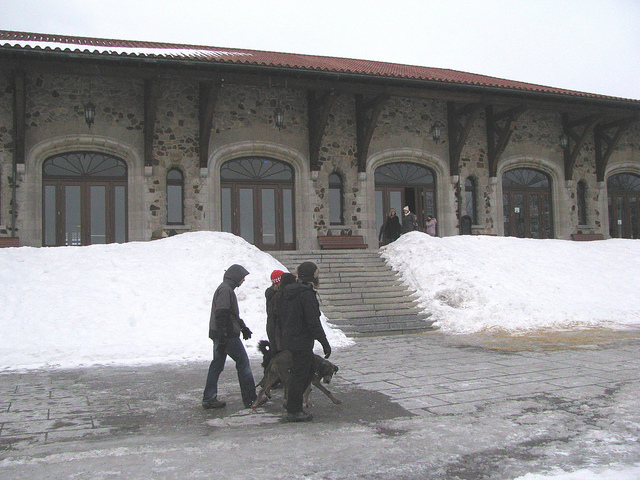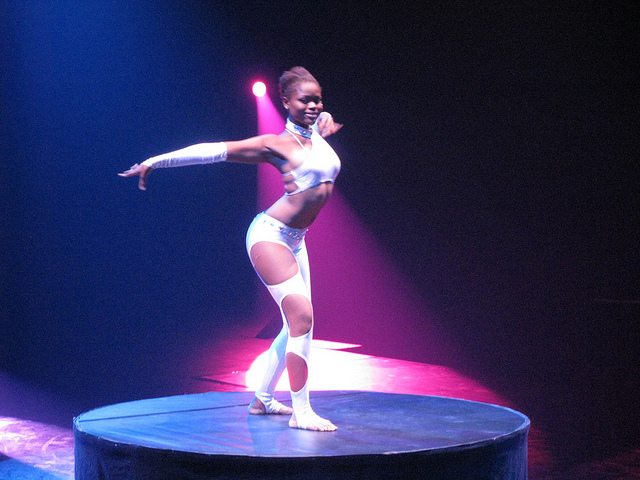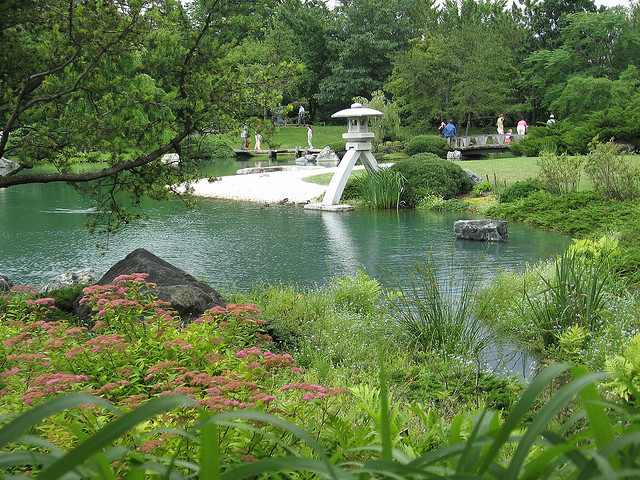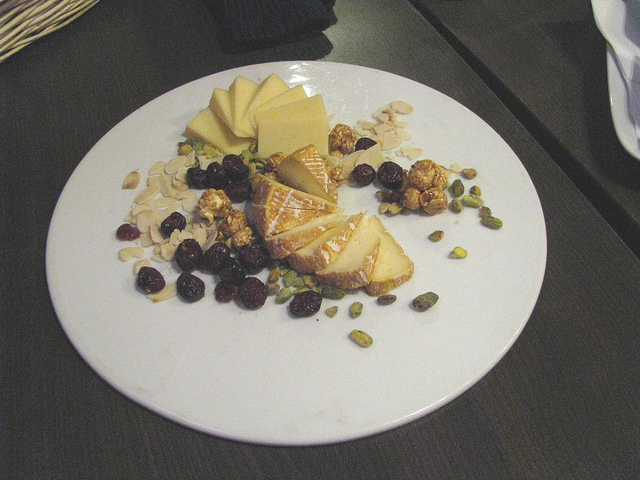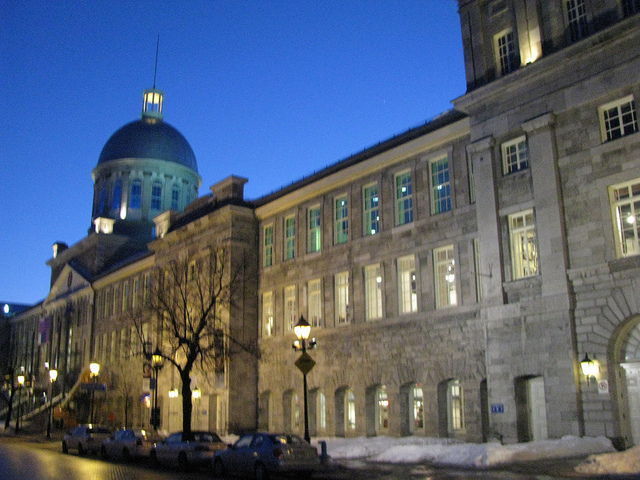After an interesting and tasty culinary tour of Old Montreal and a short rest back at the historic Auberge Bonaparte, we were in for a real treat in the afternoon: snow-shoeing on Mont Royal. When exploring urban destinations, I always try to combine some outdoor activity with more traditional city activities such as visits to museums or architectural tours. After a brief 20 minute taxi ride we had arrived at the top of Mont Royal, the three-peaked mountain that rises right in the middle of the city. We were to meet a guide from an organization called “Les Amis de la Montagne” at the Maison Smith, an interpretive centre at the entrance of Mount Royal Park.

Although I am real sports nut and love winter sports, I had never snow-shoed before, but our young guide Eric from Les Amis de la Montagne quickly turned us into experts. It took a minute or two to get used to these metal contraptions on our feet, but they were amazingly effective at giving us grip in the icy, hardpacked snow on the mountain.
Les Amis de la Montagne is a non-profit organization that exists to protect and enhance Mount Royal through community involvement and environmental education. The group provides all sorts of outdoor equipment for activities on the mountain which include cross-country skiing, snowshoeing, skating, Nordic kicksledding, inner tubing, pedal-boating and bird watching. In addition, the organization provides guided walking tours, special events and conferences to bring the mountain closer to local Montrealers and tourists.

Our young and enthusiastic guide Eric, an animation and cultural studies student, was obviously passionate about the mountain and about sharing his knowledge with us. As we started getting comfortable with our snow shoes, we would stop occasionally and listen to the knowledge that Eric shared with us. First, he clarified that Mount Royal is not actually a former volcano, but it is part of a very old volcanic complex and was created by a magmatic intrusion into the sedimentary rocks of the area. The magma never reached the surface as lava, but the core of Mount Royal does consist of resistant igneous rock.
Eric enlightened us about the tree cover on the mountain which consists mainly of oak, maple and pine trees. Some parts of the area were clear cut in the late 1800s to build water reservoirs, and were reforested with pine trees, which results in clear demarcations in the tree cover in different parts of the mountain. During the 1950s many of the trees were removed due to “morality cuts” to prevent people from getting frisky in the forest. Reforestation programs have largely been successful at undoing this damage as well as the damage caused by the Ice Storm of 1998. As you can imagine, overuse is a major problem for the environmental preservation of this mountain, given that it is located in the heart of a huge metropolitan area.

We also learned that Mount Royal Park, opened in 1876, was a creation of famous landscape designer Frederick Law Olmsted, who had also created New York City’s Central Park. Eric explained to us that Beaver Lake was built in the 1930s as a job creation project. Several hospitals were built on the slopes of Mount Royal – including McGill University’s teaching hospitals, the Royal Victoria Hospital and the Montreal General Hospital. The west side of the mountain is home to one of Montreal’s most famous landmarks: St. Joseph’s Oratory, Canada’s largest church.
Along the way we studied the sedimentary and igneous rocks that make up this mountain and Eric also pointed out various animal tracks in the snow; most of them were from squirrels, but we even saw some footprints left by foxes. Some of the trees contain numerous holes that are created by woodpeckers, and Eric explained that these birds have long tongues that actually cushion the brain from the impact of the wood-pecking.

One of the highlights of our snow-shoeing tour was a visit to the Belvedere Kondiaronk, a large semi-circular plaza with a chalet and a breath-taking view over downtown Montreal. None of the skyscrapers are allowed to be taller than the mountain, and from this spot you can see far beyond the city to the South Shore and the Montérégie Mountains.

The last highlight of our excursion was our final stop just west of the big chalet, when Eric pulled out a thermos bottle of mulled wine that he shared with us. The sweet red wine combined with the crisp winter air and the physical exercise that we had just completed was just the perfect way to end a great winter outing. As a matter of fact, we enjoyed snow shoeing so much that we considered to buy some for ourselves. At the end of this thrilling outdoor experience we wanted to give Eric a tip but he refused to accept it and actually suggested that we donate any tips to Les Amis de la Montagne. Eric had been a wonderful guide.

Back at our hotel, the historic Auberge Bonaparte, I enjoyed a long soak in the jetted tub before getting ready for our evening program. We were planning to check out Crescent Street – one of Montreal’s most popular entertainment areas with many art galleries, boutiques, nightclubs bars and restaurants. Our destination for tonight was Thursday’s Resto Bar Club, a big entertainment complex that is also connected with the Hôtel de la Montagne.
In the lobby of the hotel I met up with Torrance Raguenau, son of the founder Bernard Ragueneau who started Thursdays in 1973. The hotel came later in 1981 and was built inside a 1960s apartment complex. Today, Hôtel de la Montagne has 143 mostly deluxe rooms and five suites. At 600 square feet, the rooms are very spacious and all of them feature a private balcony and a large marble-clad bathroom. The lobby is an impressive space with a special old world flair – opulent chandeliers, decorative large-size elephant sculptures from Thailand and a rotating fountain featuring a lady with butterfly wings that Bernard Ragueneau picked up in San Francisco. This is definitely not your standard franchise-type hotel.

Then Torrance took me through an underground tunnel to the other side of the complex that features a dance club on the lower floor, a pub on the middle floor and a French brasserie upstairs. Altogether these three establishments can hold 1200 people. We took a seat in the Art Nouveau-inspired brasserie “Les Beaux Jeudis” and were looking forward to our dinner.
The brasserie features a large menu with a wide selection of hot and cold appetizers, an extensive range of side and dinner-size salads, and a large selection of seafood and meat dishes including preserved duck leg, slow cooked lamb shank, flank steak and calf liver. We settled on a nice French onion soup to start, followed by “Escargot a la Bourguignonne” – snails in garlic butter, and a grilled filet mignon. The fitting high point of this lovely dinner was dessert: Crepes Suzette. Torrance made the crepes himself and I watched him flambée them skilfully with Grand Marnier.

This delicious dessert ended an enjoyable evening and we braced the cold and took the subway back to Old Montreal to catch a really good rest before another exciting day.
Related Videos:
Eric gives us an explanation of Les Amis de la Montagne
We get an introduction to snow-shoeing on Mount Royal
Our guide explains the forest and the work of woodpeckers
We see the results of a tree that has been worked on by woodpeckers
Eric explains the “morality cuts” of the 1960s
We learn about the hospitals that surround Mount Royal
Eric explains Frederick Law Olmstead’s design of the park
